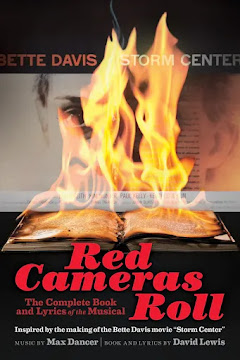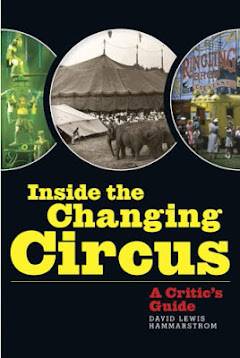Book Review
The Killing of Lord Sanger, by Karl Shaw
Icon Books -- now available on Amazon Kindle. The book edition is due out March 4
Mourned by the multitudes in the wake of his shocking death, did Britain's Barnum really deserve their adoring accolades? An enthralling new book by Karl Shaw, set in circus land UK during the Edwardian era, tells two interlocking stories, one of the legendary circus king, the other about the search for the man who murdered him.The Killing of Lord George opens our eyes on what it was really like trouping through the British Isles during an age of brawling competition between shows, when the survival of the fittest one season was no guarantee of the same for the next.
As for the morbid murder mystery, told in alternating chapters, this makes for a different kind of read which some may find off-putting -- back and forth between sawdust rings and homicide investigations. Oddly, as I returned to each, I was keener on its side of the narrative moving forward. A rare two for one.
George Sanger carried on the lavish spectacles established by circus founder, Phillip Astley, once the latter was gone. He started out in his father’s circus as a magician, and would became UK’s greatest showman, according to a Times of London obit quoted in this admirably researched bio. Sanger and his brother, John, at one time had a multitude of circus rings circling Europe. All of which earned him high praise from The New York Times, calling him "the English Barnum."
I knew nothing of the man himself other than his prolongation of the Astley legacy, and here his life comes suddenly spilling out, as messy as a clogged up sink faucet not unplugged in over a hundred years. Which makes this man a difficult character to like. Brace yourself. Among many devious attributes, Sanger was a chronic liar who may have self-anointed himself a Lord. He possessed a natural — or shrewdly staged — gift for philanthropy, so widespread as to enjoy the status of “a national treasure, loved and respected by all,” in the words of Shaw. It’s the darker side of Mr. Sanger that spreads gloom through the pages.
Away from the spotlights and glitter, let’s start on the home front. “He never let go of his hatred for his son in law,” writes Shaw, the sin being that his daughter had dared to wed a headline performer with a “celebrated rival.” This anger applied to other relatives along the way.
Savage Task Master
Onto the shows: The prim, compact circus lord could turn into a quality-control monster against underachieving performers. “He was sadistic if an artist failed during a performance.” reveals Shaw, to whose credit should go honors for such unfaltering attention, for it surely does nothing to gild his otherwise sunny portrait of the man’s boundless humanity and good will to others. For instance, take Astley’s treatment of a young wire walker who fell from her perch more than once. In stormy reaction, the offended boss “offered her a penknife from his pocket and said ‘here, don’t cut your throat, cut your bloody head off!’ Scores of performers came and went, and only the bravest or most loyal stayed the course. Those who fell short had their contracts terminated with a short: ‘Call yourself an actor? get off my stage!'"
Animal cruelty? How about human cruelty? I know how callously heartless circus owners can be, but I can’t think of one quite this sociopathic.
Perhaps The Killing of Lord George could have spent more time prose painting the man’s laudatory posters and programs, and the name dropping could had been more elaborately fleshed out. There is not a single image of circus, or the word itself, on the book’s cover. It’s biggest failure, in my view, is a glaring lack of full-page illustrations, preferably in color, that scream CIRCUS. Grainy black and white images of news stories, diagrams and photos serve the story well, but may fail to captivate a wider audience. Sleuthing the sawdust shadows for tales of hardship and mayhem, Shaw cunningly compels with gripping accounts of the sudden dangers inherent in tent trouping. It’s a miracle that none of the Sanger's were burned to death in the cinder box wagons in which they lived. Thieves and rivals wishing to loot and defile could sneak up from every which direction. Inglorious weather, bum crowds, and periodic outbreaks of cholera, shuttered circus folk into shivering, food-deprived retreat. In the worst of seasons, we read, some literally “starved to death.” Really?The Lion Queen's Favorite
Sanger's obvious envy for his American rivals who competed with him on his own turf, mainly William F. Cody and Barnum & Bailey, produced a torrent of petty unflattering scorn and ridicule, some published in his memoir. "There is nothing that American showman have ever done that Englishmen have not done first and not done better." Blatantly false. For one thing, the failed three ring format that Sanger claimed to have first used in 1860 was far better used when Barnum & Bailey took it on the road in 1881 -- if, in fact, they had "stolen" the idea from Sanger, as he claimed. There is insufficient evidence to support the boast. Another grandiose lie?
Another Man on Another Night
The darker side of our problematic genius comes to a grizzly end when he is murdered by an axe and razor, the most likely suspect being a young man who had shared his bedroom by night, until being ejected. Shaw covers this in a strangely incomplete manner. Explains he, ever so politely without ever dropping the H word, the relationship between the two “followed a predictable course. He (Sanger) would quickly form a very close attachment with his new favorite, shower him with presents and take him wherever he went. In Herbert Cooper’s case at least, this intimacy included sharing a bedroom. Then, just as quickly, George would drop him and replace him with another.”
Such was the fate of the tall and handsome, 29-year old Cooper “usurped in Sanger’s affections by Arthur Jackson, just as surely as Herbert himself had been a substitute for someone else. One day he was the old man's special friend, the next he was effectively ostracized, excommunicated from the Park Farm inner sanctum.”
Notice how much fun our author seems to have over that last line, which only makes it more incredible that he would not have at least raised the subject of a homosexual union or fetish of some kind, if only to raise the issue and put it to rest. I was left fairly dumbfounded.
Shaw defers to the press, plenty interested in Sanger’s relations with Cooper. Some newspapers suspected revenge being the motive, had Cooper in fact been the assailant. In the end, sketchy testimony leaves a muddled impression, although Shaw wishes us to believe otherwise. That is, that the killer was not Cooper. The Times at the time believed he was. Others believe it still to be a mystery.
There is much to hold your interest in this offbeat treat. I have never dug deep enough to realize how the Brits were as drawn to the kink and gore of side shows as we were over here. Another topic that held my fascination was the intersection between British and American circus owners over both their rivalries and the exchange and/or leasing of each other’s ideas, with vividly described cameos from likes of P.T. Barnum and William Buffalo Bill Cody. After all, we and they were in the same business when “elephants were the perpetual Victorian circus favorites.” Which makes this book a must-read for serious scholars and lovers of circus history.
I’ll go out with a teaser. You could never guess how Cooper’s life came to an end.
Shaw is also the author of The First Showman: The Extraordinary Life of Philip Astley.
Memo to Masterpiece. If you can’t see the drama in this, you don't deserve to be funded. Over to you, ITV?


































2 comments:
A great review, written with all the passion and grit of Sanger himself! Your simile "As messy as a clogged up sink not unplugged in over 100 years" is the best I've read in a long time.
You're right about the lack of circus imagery or wording on the cover. The tagline should have been "A tale of murder and deceit in the Edwardian circus" at the very least.
As for a TV adaptation... would they dare make such a dark tale, today???
Thanks, Douglas, for your generous thumbs up. This was a very challenging book to review, it has so many moving parts.
You wonder if Masterpiece would dare “make such a dark tale, today???”
Sanger’s life was so packed with drama, there is so much to draw from. Queen Victoria at the circus. The American invasion lead by Barnum. The pack of wolves that escaped Sanger’s circus (which he staged, as you detail in your review), driving half of London into a panic. So much. I have hungered my whole adult life for an outstanding cinematic circus treatment in documentary or drama, only to be let down time and time again. Masterpiece could have a field day with this one, although they might resist a full-tilt Hitchcockian end, which it surely has!
Post a Comment